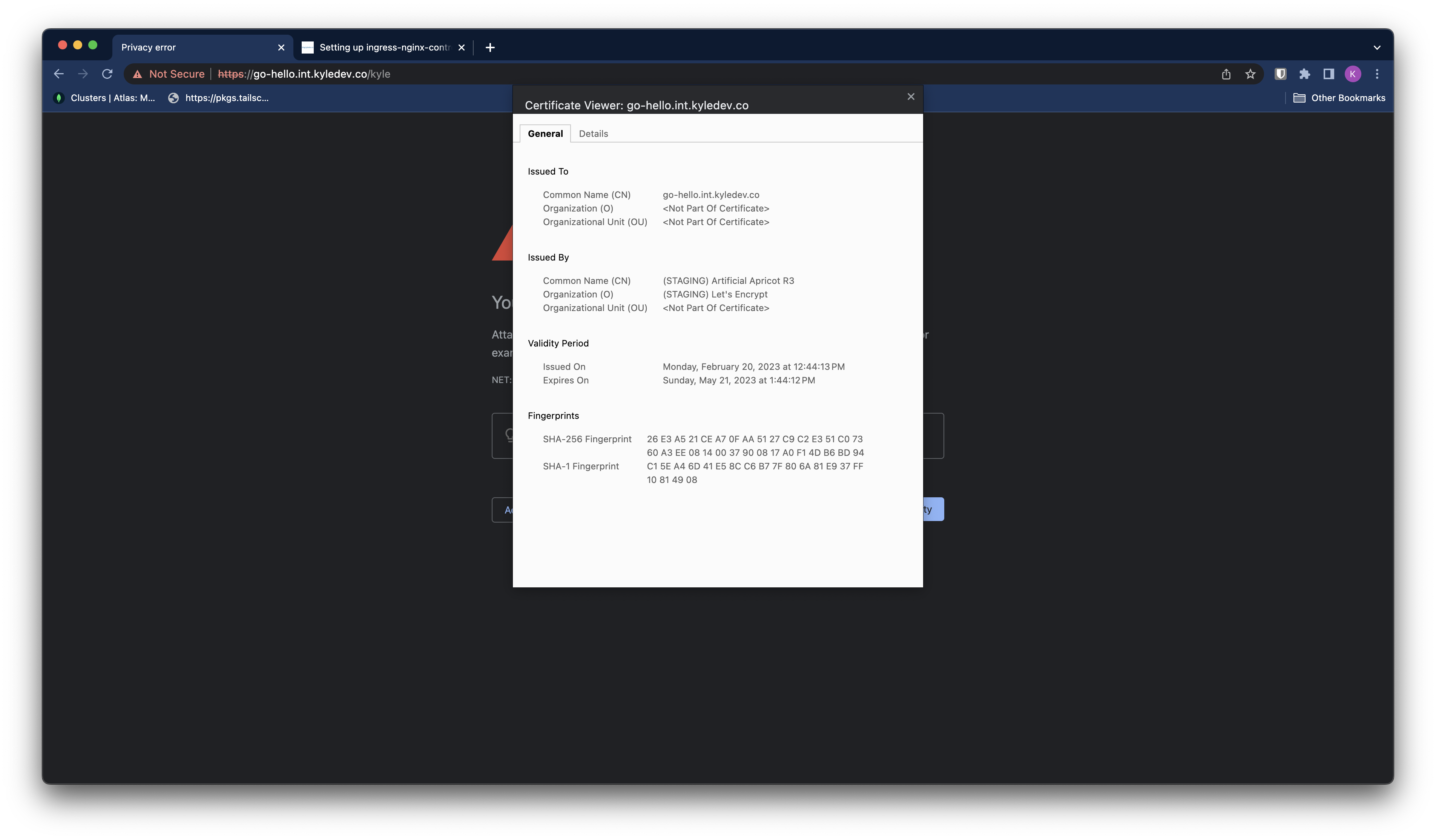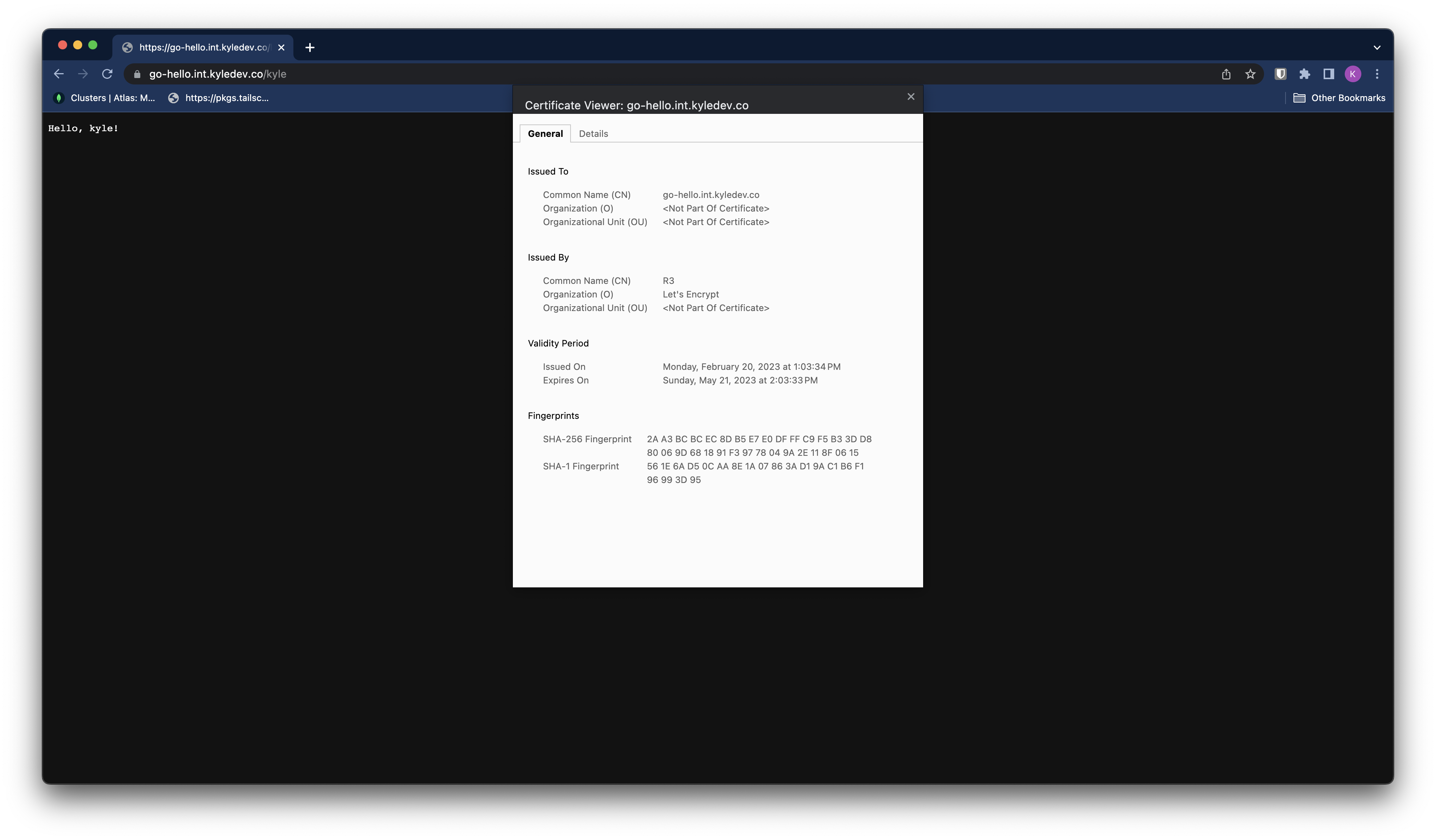Setting up local DNS using pihole and ingress-nginx-controller
I don’t want to memorize different IP addresses that metallb assigns to services running in my k3s cluster. I want a set up where *.int.kyledev.co routes to the ingress-controller running in my cluster. We can do that with pihole and ingress-nginx-controller.
Reflector
Reflector is a Kubernetes addon designed to monitor changes to resources (secrets and configmaps) and reflect changes to mirror resources in the same or other namespaces.
We want to create a wildcard certificate for our cluster, and have that secret replicated across all the namespaces that needs the certificate.
Installation
$ kubectl -n kube-system apply -f https://github.com/emberstack/kubernetes-reflector/releases/latest/download/reflector.yaml
serviceaccount/reflector created
clusterrole.rbac.authorization.k8s.io/reflector created
clusterrolebinding.rbac.authorization.k8s.io/reflector created
deployment.apps/reflector created
$ kubectl get pods -n kube-system
NAME READY STATUS RESTARTS AGE
local-path-provisioner-79f67d76f8-6jh6f 1/1 Running 0 5d23h
coredns-597584b69b-69tdx 1/1 Running 0 5d23h
metrics-server-5f9f776df5-cdm9t 1/1 Running 0 5d23h
reflector-5c99b9b7c9-tbdbn 1/1 Running 0 6m27s
Looks good to go.
Cert Manager
Cert-manager adds certificates and certificate issuers as resource types in Kubernetes clusters, and simplifies the process of obtaining, renewing and using those certificates. Checkout out the docs for more information.
Installation
I’ll be installing cert-manager using a manifest, but feel free to follow the docs for other options such as helm.
kubectl apply -f https://github.com/cert-manager/cert-manager/releases/download/v1.11.0/cert-manager.yaml
Verify the installation. I’ve had cert-manager installed for a few days now.
$ kubectl get pods -n cert-manager
NAME READY STATUS RESTARTS AGE
cert-manager-cainjector-ffb4747bb-g5jqp 1/1 Running 0 5d21h
cert-manager-webhook-545bd5d7d8-tzhzd 1/1 Running 0 5d21h
cert-manager-7dfffc7574-hdcqs 1/1 Running 0 4d23h
LetsEncrypt Challenges
We’ll be using LetsEncrypt as our Certificate Authority.
In order to be issued a certificate, we need to complete a challenge. There are two challenge options we can complete. Cert-Manager can be configured to attempt either of the two challenges.
HTTP-01 Challenge
For the HTTP-01 Lets Encrypt gives a token to your ACME client, and your ACME client puts a file on your web server at http://<YOUR_DOMAIN>/.well-known/acme-challenge/<TOKEN>.
This assumes that your cluster is externally reachable, which ours is not, so we’ll not be going this route.
DNS-01 Challenge
The DNS-01 asks you to prove that you control the DNS for your domain name by putting a specific value in a TXT record under that domain name. Our cluster does not have to be externally reachable to perform this challenge.
LetsEncrypt has a list of supported providers we can use. We’ll be using cloudflare.
Creating a cluster issuer using Cloudflare for DNS-01
We’ll be following the docs for using cloudflare.
First, we need to create a secret for our cloudflare API token.
apiVersion: v1
kind: Secret
metadata:
name: cloudflare-api-token-secret
namespace: cert-manager
type: Opaque
stringData:
api-token: <your-api-token>
Next, we’ll need to create a ClusterIssuer to handle issuing certificates. We’ve configured our issuer to use DNS-01 with cloudflare as our provider, referencing the cloudflare token secret we created a few moments ago.
LetsEncrypt has a staging API we can use for testing our cluster issuer setup. We’ll create a staging issuer first to test our configurations.
apiVersion: cert-manager.io/v1
kind: ClusterIssuer
metadata:
name: letsencrypt-staging
spec:
acme:
server: https://acme-staging-v02.api.letsencrypt.org/directory
email: <your-email>
privateKeySecretRef:
name: letsencrypt-staging
solvers:
- dns01:
cloudflare:
email: <your-email>
apiTokenSecretRef:
name: cloudflare-api-token-secret
key: api-token
Verify your ClusterIssuer is ready to go.
$ kubectl get clusterissuer -n cert-manager
NAME READY AGE
letsencrypt-staging True 5d21h
I want the certificate secret to be created in the namespace go-hello, so go ahead and create that namespace now if you’re following along.
$ kubectl create namespace go-hello
namespace/go-hello created
Next, the wildcard certificate.
We need to tell reflector which namespaces to replicate the tls secret to. Check out the secretTemplate in our certificate.
apiVersion: cert-manager.io/v1
kind: Certificate
metadata:
name: wildcard-kyledev-tls-staging
namespace: cert-manager
spec:
secretName: wildcard-kyledev-tls-staging
issuerRef:
name: letsencrypt-staging
kind: ClusterIssuer
secretTemplate:
annotations:
reflector.v1.k8s.emberstack.com/reflection-allowed: "true"
reflector.v1.k8s.emberstack.com/reflection-allowed-namespaces: "go-hello"
reflector.v1.k8s.emberstack.com/reflection-auto-enabled: "true"
commonName: "*.kyledev.co"
dnsNames:
- "*.kyledev.co"
- "*.int.kyledev.co"
Wait for your certificate to become ready. Reflector should create the certificate secret in our go-hello namespace automatically.
$ kubectl get cert -n cert-manager
NAME READY SECRET AGE
wildcard-kyledev-tls-staging True wildcard-kyledev-tls-staging 15s
$ kubectl get secret -n go-hello
NAME TYPE DATA AGE
wildcard-kyledev-tls-staging kubernetes.io/tls 2 36s
Ingress-nginx
We’ll be using ingress-nginx as our ingress controller. An Ingress controller is a specialized load balancer for Kubernetes (and other containerized) environments.
Installation
Feel free to follow the docs to figure out installation for your cluster.
I’ll be installing via manifest, again.
Assuming you’ve set up loadbalancing, such as metallb, we’ll be going with the cloud provider manifest so we can expose the ingress controller via external-ip.
Check out how to install metallb if you’re interested.
kubectl apply -f https://raw.githubusercontent.com/kubernetes/ingress-nginx/controller-v1.6.4/deploy/static/provider/cloud/deploy.yaml
Verify the ingress controller is up and running
$ kubectl get pods -n ingress-nginx
NAME READY STATUS RESTARTS AGE
ingress-nginx-admission-patch-hmf9z 0/1 Completed 0 4d22h
ingress-nginx-admission-create-bwzpg 0/1 Completed 0 4d22h
ingress-nginx-controller-6b94c75599-plj2z 1/1 Running 0 4d22h
$ kubectl get svc -n ingress-nginx
NAME TYPE CLUSTER-IP EXTERNAL-IP PORT(S) AGE
ingress-nginx-controller LoadBalancer 10.43.142.121 10.0.1.0 80:32628/TCP,443:32568/TCP 4d22h
ingress-nginx-controller-admission ClusterIP 10.43.85.161 <none> 443/TCP 4d22h
Notice how metallb assigned an external-ip 10.0.1.0 to the ingress controller. Remember this guy for later.
Our ingress controller is set up and good to go.
Pihole for Local DNS
If you haven’t set up pihole yet, checkout this post. The rest of this post is heavily based on the linked setup.
We’re going to be updating our pihole deployment for local dns lookups with our domain kyledev.co. For my internal services, I want to access them via *.int.kyledev.co.
Let’s update our custom dnsmasq for pihole to point int.kyledev.co to our new ingress-nginx-controller external-ip of 10.0.1.0.
apiVersion: v1
kind: ConfigMap
metadata:
name: homelab-pihole-custom-dnsmasq
labels:
app: pihole
chart: pihole-2.11.1
release: homelab
heritage: Helm
data:
02-custom.conf: |
addn-hosts=/etc/addn-hosts
address=/int.kyledev.co/10.0.1.0
addn-hosts: |
05-pihole-custom-cname.conf: |
Delete the running pihole pod so it picks up the new config map changes.
$ kubectl get pods -n pihole
NAME READY STATUS RESTARTS AGE
homelab-pihole-989bd4c59-vf9kb 1/1 Running 0 2d19h
$ kubectl delete pod/homelab-pihole-989bd4c59-vf9kb -n pihole
pod "homelab-pihole-989bd4c59-vf9kb" deleted
$ kubectl get pods -n pihole
NAME READY STATUS RESTARTS AGE
homelab-pihole-989bd4c59-jjdcj 0/1 Running 0 9s
Testing it all out
We’ll be deploying a sample hello world service to test it all out. We’ll be using a go service I used for testing out CI/CD with tailscale and github actions. I’ll probably create a post for this later.
First, lets note the annotations on the Ingress.
cert-manager.io/cluster-issuer: letsencrypt-staging tells our ClusterIssuer to issue a certificate for this ingress. Notice we are pointing to our staging ClusterIssuer. We’ll create a production issuer after we validate our staging issuer.
kubernetes.io/ingress.class: nginx tells our ingress-nginx-controller it will be managing this ingress.
Additionally, we’re pointing to our wildcard staging certificate wildcard-kyledev-tls-staging
apiVersion: networking.k8s.io/v1
kind: Ingress
metadata:
annotations:
cert-manager.io/cluster-issuer: letsencrypt-staging
kubernetes.io/ingress.class: nginx
name: go-hello
namespace: go-hello
spec:
rules:
- host: go-hello.int.kyledev.co
http:
paths:
- backend:
service:
name: go-hello
port:
name: http
path: /
pathType: Prefix
tls:
- hosts:
- go-hello.int.kyledev.co
secretName: wildcard-kyledev-tls-staging
Heres the full kubernetes yaml for the deployment, including the ingress.
Hello World YAML
apiVersion: v1
kind: Service
metadata:
name: go-hello
namespace: go-hello
spec:
ports:
- name: http
port: 80
targetPort: 8080
selector:
app: go-hello
---
apiVersion: apps/v1
kind: Deployment
metadata:
name: go-hello
namespace: go-hello
spec:
selector:
matchLabels:
app: go-hello
template:
metadata:
labels:
app: go-hello
spec:
containers:
- image: ghcr.io/kdwils/go-hello:aa0c06eb9ecf122693445393216b177ee800fc18
imagePullPolicy: Always
name: go-hello
ports:
- containerPort: 8080
name: http
resources:
limits:
cpu: 500m
memory: 128Mi
---
apiVersion: networking.k8s.io/v1
kind: Ingress
metadata:
annotations:
cert-manager.io/cluster-issuer: letsencrypt-staging
kubernetes.io/ingress.class: nginx
name: go-hello
namespace: go-hello
spec:
rules:
- host: go-hello.int.kyledev.co
http:
paths:
- backend:
service:
name: go-hello
port:
name: http
path: /
pathType: Prefix
tls:
- hosts:
- go-hello.int.kyledev.co
secretName: wildcard-kyledev-tls-staging
Deploy the hello world service to your cluster.
$ kubectl apply -f hello-world.yaml
service/go-hello created
deployment.apps/go-hello created
ingress.networking.k8s.io/go-hello created
$ kubectl get pods -n go-hello
NAME READY STATUS RESTARTS AGE
go-hello-654db7765c-jsx7s 1/1 Running 0 3m27s
Check out the ingress as well. Notice how the address is the same as our ingress-nginx-controller load balancer.
$ kubectl get ingress -n go-hello
NAME CLASS HOSTS ADDRESS PORTS AGE
go-hello <none> go-hello.int.kyledev.co 10.0.1.0 80, 443 3m51s
And we can head over to go-hello.int.kyledev.co to verify everything is working.
But theres a problem…https isn’t working? That’s because we’re using the staging LetsEncrypt certificate.

LetsEncrypt prod issuer
Lets set up our prod issuer since we can see that our staging issuer is working as intended.
apiVersion: cert-manager.io/v1
kind: ClusterIssuer
metadata:
name: letsencrypt-prod
spec:
acme:
server: https://acme-v02.api.letsencrypt.org/directory
email: <your-email>
privateKeySecretRef:
name: letsencrypt-prod
solvers:
- dns01:
cloudflare:
email: <your-email>
apiTokenSecretRef:
name: cloudflare-api-token-secret
key: api-token
Followed by our prod wildcard certificate.
apiVersion: cert-manager.io/v1
kind: Certificate
metadata:
name: wildcard-kyledev-tls-prod
namespace: cert-manager
spec:
secretName: wildcard-kyledev-tls-prod
issuerRef:
name: letsencrypt-prod
kind: ClusterIssuer
secretTemplate:
annotations:
reflector.v1.k8s.emberstack.com/reflection-allowed: "true"
reflector.v1.k8s.emberstack.com/reflection-allowed-namespaces: "go-hello"
reflector.v1.k8s.emberstack.com/reflection-auto-enabled: "true"
commonName: "*.kyledev.co"
dnsNames:
- "*.kyledev.co"
- "*.int.kyledev.co"
Our updated ingress will look largely the same, however we’ll point to our new prod ClusterIssuer with the annotation cert-manager.io/cluster-issuer: letsencrypt-prod. Additionally, we need to point to he new tls secret wildcard-kyledev-tls-prod.
apiVersion: networking.k8s.io/v1
kind: Ingress
metadata:
annotations:
cert-manager.io/cluster-issuer: letsencrypt-prod
kubernetes.io/ingress.class: nginx
name: go-hello
namespace: go-hello
spec:
rules:
- host: go-hello.int.kyledev.co
http:
paths:
- backend:
service:
name: go-hello
port:
name: http
path: /
pathType: Prefix
tls:
- hosts:
- go-hello.int.kyledev.co
secretName: wildcard-kyledev-tls-prod
And it should magically work!
